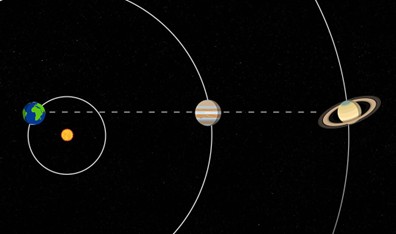AAA: What’s a Planetary Parade?
You’ve likely come across news articles or headlines about a planetary parade happening in the sky recently. In this article, astronomer Rosie Braunholtz explains what makes a planetary parade special and how you can catch a glimpse of it.
AAA: What’s a Planetary Parade?
Summary: A planetary parade refers to a rare event when several planets appear in the same region of the sky. While “planetary alignment” is often the word used to describe this phenomenon, it doesn’t mean the planets are all going to be in one straight line in space. This would be near impossible because of all the different orbital speeds and angles of the planets (seeing all the planets line up in the sky within 1 degree of each other would occur once every 13.4 trillion years). Instead, it means that the planets are aligned in the same half of the sky. This is very exciting because although it’s not extremely rare, the planets being on the same side of the Sun is a pretty special occasion. It means we can see multiple planets at the same time. The current event features four bright planets, with five being visible by the end of February—Mercury, Venus, Mars, Jupiter, and Saturn— which hasn’t occurred since 2022 and won’t happen again until 2028. Neptune and Uranus are also visible, but only to those with a telescope.
On most nights, if the weather is clear, at least one bright planet is visible in the sky. It’s fairly common even to see two planets, but occasionally three or more can be seen with the naked eye. So while “planetary parades” aren't extremely rare, they don't occur every year, making them worth watching when they do happen.
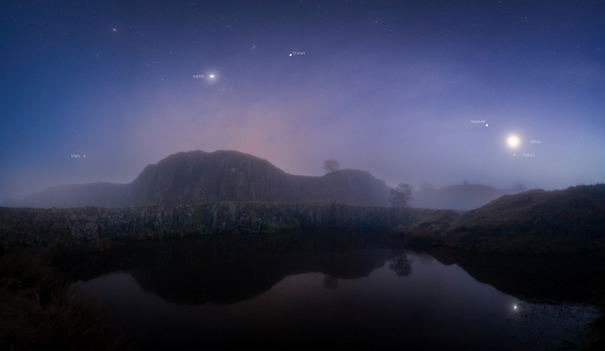
Image: Picture of the planetary parade taken by Dan Monk in January 2025. This is a 12 shot panorama that spans roughly 180° side to side.
What is a planetary parade?
Parade, alignment, conjunction, super conjunction, opposition, syzygy!?? Do they mean the same thing??
You’ve probably been hearing many people and articles call this an alignment, which gives the impression that the planets will all be lined up in space as though we can stick a long rod straight through the middle of all of them. This isn’t the case however!
The planets are all orbiting the Sun in a roughly flat disk. And so, randomly in their orbits, you sometimes get a few that line up together which we can see from Earth. However all the planets are going at different speeds which makes this not very common, additionally the orbits are tilted to different degrees relative to the Sun’s equator, which makes a “perfect” straight line virtually impossible!
Even though we’ll never see all the planets line up perfectly in space, we do occasionally see a few planets and objects near each other in the sky from our perspective. When we get space objects appearing close together from our point of view we call it a conjunction.
Image left: Diagram of a conjunction of Jupiter and Saturn. From our perspective, these two planets are very close together in the sky. In reality Saturn is much further away than Jupiter. Credit: The Planetary Society
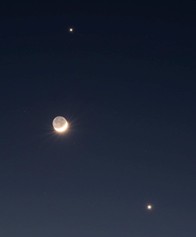
Image right: Here’s a beautiful picture of the Moon (380 thousand kilometres away), Venus (170 million kilometres) and Jupiter (800 million kilometres) appearing close together in the sky. Taken by our astrophotographer Dan Monk
So... what’s happening right now?
What we have happening right now is a sort of conjunction of the planets, or alignment - depending on how generous you’re feeling. The planets aren’t exactly very close together in the sky from our perspective, or in a perfect alignment in space. BUT! they are in the same general region in the sky, which doesn’t happen too often.
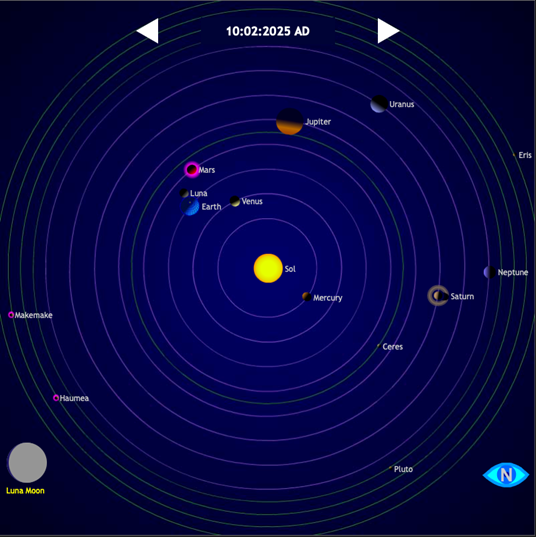
Image: Our solar system on the 10th of February. You can see that the planets are pretty much all on one side of the Sun. Credit: ThePlanetsToday.com
As you can see from the picture above, the Sun’s children are gathered mostly to one side. Meaning we can see almost all our brothers and sisters at once! Because the solar system is a flat-ish disk, at sunset they all appear one after the other in a pretty line. That’s why “planetary parade” is a wonderful phrase, even though it’s not a scientific term in astronomy.
How rare are they?
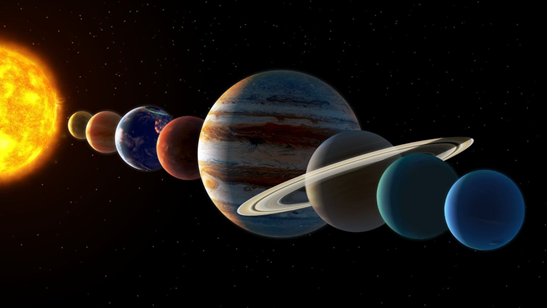
Image: All 8 planets in a perfect line! This is not the ”alignment” we’re seeing now. The actual term for when space objects lineup is a syzygy. Which is a very fun word to say. The chances of an event like this happening with all the planets is zero, due to all the different orbits and angles of the planets. Credit: StarWalk
Having the planets appear in one half of the sky is a special occasion. The last similar parade occurred in 2022, but this winter's event includes even more! At the end of February, we’ll have the chance to catch all 5 bright planets: Mercury, Venus, Mars, Jupiter and Saturn. Which doesn’t come around too often. The next one like this will occur in October 2028!
If we wanted to see the planets even closer together that would be a much rarer event. Even a loose grouping in one quadrant (90-degree sector) is rare, happening just seven times in the current millennium.
If we wanted to see all 7 other planets line up in the sky within 1 degree of each other, the probability would be about once every 13.4 trillion years. In comparison the Universe is 13.8 billion years old. So, we’d be waiting a good while. The movies make it seem like such a common occurrence, eh?
How can I see it?
When trying to find planets in the night sky, the best thing to do is look for the brightest stars in the sky that aren’t twinkling and seem to all be following each other in a line.
The planets move slowly around the Sun, so there’s usually a period of at least a few days if not a few weeks to see the parade. As for right now, Venus, Saturn, Jupiter and Mars have been visible since the end of December, and will continue to be visible for a couple weeks (unless you have a telescope, Uranus and Neptune won’t be visible).
Specifically for this February there will be a small window to see all 5 bright planets at once! If you’d like to play planetary bingo with the big 5, here’s what you will have to do.
In the last week of February (from the 22nd – 25th) head outside shortly after sunset, towards the south-west you will see an extremely bright object (the brightest thing in the sky). That’s Venus! Absolutely gorgeous and the brightest planet. Use it as your beacon.
Below Venus, close to the horizon will be Saturn. It will look much dimmer compared to Venus and will be the trickiest planet to see. Saturn is the faintest visible planet, and as the month goes on it will get closer to the Sun and become hard to see against the brightening twilight sky.
Mercury is here to rescue us however! Mercury is a very bright planet and will be visible for about an hour after sunset during this time (look very close to the horizon near the Sun). On the 24th of February, it will be in conjunction with Saturn! Giving you a nice bright target to find first, to then jump to the dimmer Saturn next to it – though you still may need some binoculars to find it.
Following the line that goes from Venus, continue up until you see Jupiter, high up and towards the south in the constellation of Taurus. It will be very bright. If you’re struggling to find it, find the constellation of Orion, and then follow the belt up to the right.
Then the last planet in the parade is Mars, it will be a bit beyond Orion’s left shoulder and be glowing a lovely yellow.
And BINGO! You have all the bright planets. I’d highly recommend downloading a stargazing app such as Stellarium to navigate the sky and see how the planets move each night.
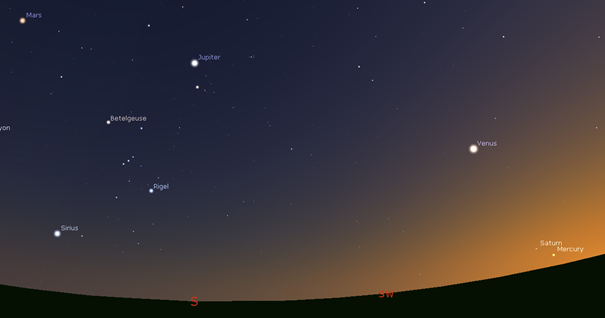
Image: Five planets all at once! This is a visulisation of what the sky will look like on the 23rd of February at 18:30 UTC. Credit: Stellarium
Will more be happening in the future?
Other recent and near-future multi-planet viewing opportunities (not including Uranus and Neptune):
• January 2016 – Four planets visible at once before sunrise
• Late April to Late August 2022 – Four planets visible at once before sunrise
• Mid-June to Early July 2022 – Five planets visible at once before sunrise
• January to mid-February 2025 – Four planets visible at once after sunset
• Late August 2025 – Four planets visible at once before sunrise
• Late October 2028 – Five planets visible at once before sunrise
• Late February 2034 – Five planets visible at once after sunset (Venus and Mercury challenging to observe)
References:
Have all 8 planets ever aligned? | Live Science
Planetary parade February 2025: When, where and how to see it | Space

